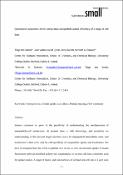Options
Quantitative assessment of the comparative nanoparticle-uptake efficiency of a range of cell lines
Date Issued
2011-12-02
Date Available
2012-03-01T11:33:16Z
Abstract
Interest continues to grow in the possibility of understanding the mechanism(s) of nanoparticle-cell interactions. At present there is little knowledge, and essentially no understanding, of the relevant length and time scales for nanoparticle-intracellular entry, and localization within cells, and the cell-specificity of nanoparticle uptake and localisation. We have investigated here the effect of particle size on the in vitro intracellular uptake of model fluorescent carboxyl-modified polystyrene nanoparticles in various cell lines commonly used for uptake studies. A range of micro- and nanoparticles of defined sizes (40 nm to 2 μm)were incubated with a series of cell types, including HeLa and A549 epithelial cells, 1321N1 astrocytes, HCMEC D3 endothelial cells and murine RAW 264.7 macrophages. Techniques such as confocal microscopy and flow cytometry were used to study particle uptake and sub-cellular localisation, making significant efforts to ensure reproducibility in a semi-quantitative approach. The results indicated that internalization of (nano)particles is highly size dependent for all cell lines studied and that the kinetics of uptake for the same nanoparticle varies in the different cell types. Interestingly, even cells non specialized for phagocytosis were able to internalize the larger nanoparticles. Intracellular uptake of all sizes of (nano)particles was observed to be the highest in RAW 264.7 cells (a specialized phagocytic cell line) and the lowest in the HeLa cells. Results suggests that (nano)particle uptake might not follow commonly defined size limits for uptake processes and highlights the variability of uptake kinetics for the same material in different cell types. These conclusions have important implications for the assessment of the safety of nanomaterials and potential biomedical applications of nanoparticles.
Sponsorship
Science Foundation Ireland
Other funder
Other Sponsorship
European Science Foundation Research Networking Programme
European Research Council (FP6)
Type of Material
Journal Article
Publisher
Wiley
Journal
Small
Volume
7
Issue
23
Start Page
3341
End Page
3349
Copyright (Published Version)
2011 Wiley
Subject – LCSH
Nanoparticles
Cell interaction
Flow cytometry
Web versions
Language
English
Status of Item
Peer reviewed
ISSN
1613-6829
This item is made available under a Creative Commons License
File(s)
Loading...
Name
Manuscript_file.pdf
Size
345.8 KB
Format
Adobe PDF
Checksum (MD5)
c82ddee60e32561c05b32cd1a3060d39
Owning collection
Mapped collections